As a rose grower, there is nothing more frustrating than walking outside to see your beloved bushes showing signs of a problem. Whether it be tiny little flying insects, beetles munching on newly opened blossoms, or diseases damaging the foliage, they are all disheartening. The goal with growing roses is to enjoy their intoxicating, velvety blooms, and pests are a colossal nemesis.
Understanding the most common problems affecting your bushes and quickly treating them is essential to having plants worthy of showing off to your family and neighbors.
If you are looking for more color, particularly purple, to add to your garden as well as something with a calming aroma, then check out our guide on how to raise lavender.
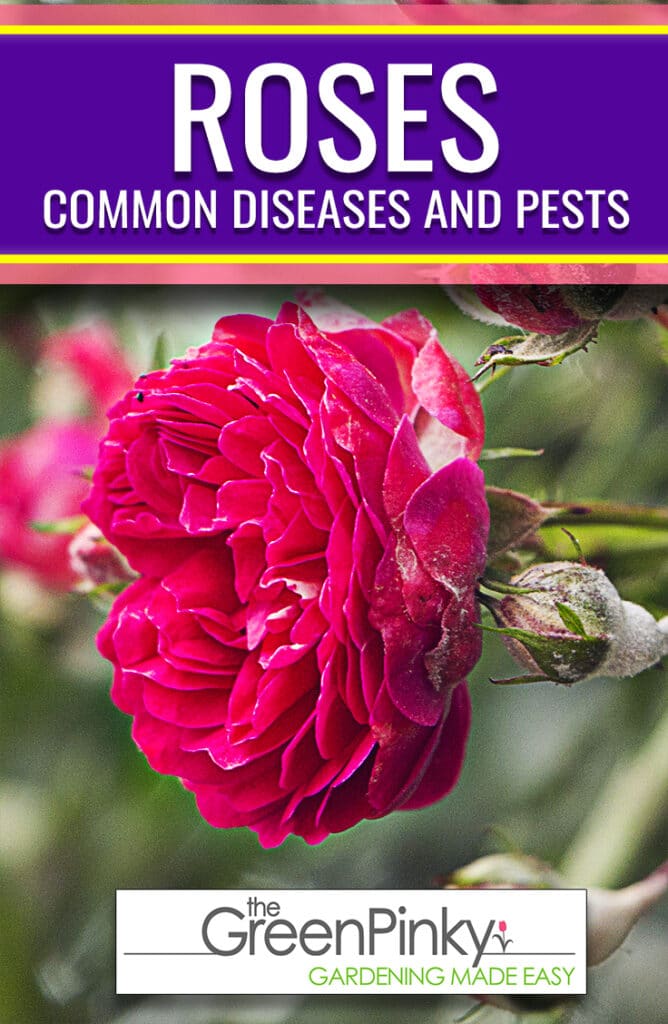
Insect Pests
The most common insect pests on rose bushes are aphids, Japanese beetles, rose scale, spider mites, and thrips. Other insects — especially those infesting other plants in your yard or garden — can make their way over to your roses and cause problems, but these five are the ones that give growers the most headaches.
Aphids
Aphids feed on the nutrient-rich sap found inside the plant. These tiny, pear-shaped bugs pierce the tissue to feed on the fluid, leaving behind a sticky substance known as honeydew. They tend to favor newly developed, rapidly growing tissue like buds and stems. An infestation can quickly become severe because they reproduce quickly.
Symptoms: distorted foliage, leaf yellowing, leaf drop
Treatment: Spray bushes with a strong stream of water from the garden hose to knock insects off. If necessary, apply a contact insecticide such as insecticidal soap, neem oil, or other product, covering the tops and bottoms of the leaves.
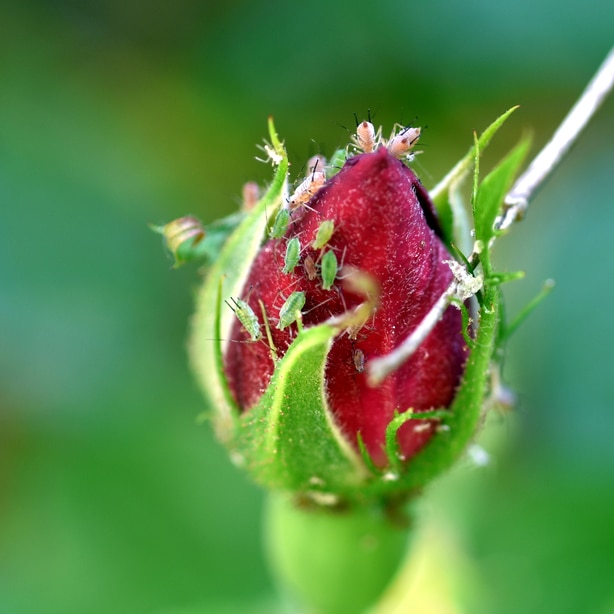
Japanese Beetles
An infestation of Japanese beetles (Popillia japonica) is easier to identify than other insect pests. Similar in size to ladybugs, their bodies are shiny, silvery-green, and covered by copper-colored wings. These insects emerge from the ground and voraciously chew on roses. They are primarily found in the Eastern US.
Symptoms: skeletonized leaves, defoliation, rosebuds eaten from the inside out
Treatment: Spray affected plants with neem oil or use traps (that we talk about in our Japanese Beetle article)

Rose Scale
Rose scale is another sap-sucking insect that feeds on the liquid in the leaves and stems of a host plant. The females are circular, about 2.5mm in diameter, and white. Males are white as well, but narrower and about 1mm long. Neither females nor males have visible legs, but both have a waxy coating making them hard to control.
Symptoms: cane decline, twig dieback
Treatment: Scrape off insects by hand in light infestations. In severe infections, apply a horticultural oil that will penetrate the waxy coating and smother them.
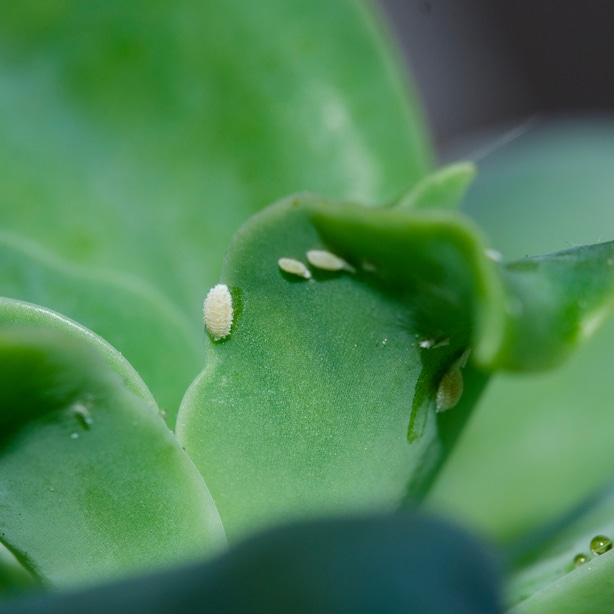
Spider Mites
Spider mites are tiny red, brown, yellow, or green pests that feed on the sap inside the leaves. Typically found on the bottom of the leaves, they pierce the waxy leaf coating to access the fluid inside. Spider mites are tiny and nearly impossible to see with the naked eye. A heavy infestation goes unnoticed before the plants show physical symptoms.
Symptoms: discolored stippling on leaves, yellowing, spider-like webbing between the leaves
Treatment: Spray bushes with a strong stream of water from the garden hose to knock insects off. If necessary, apply a contact miticide such as insecticidal soap, neem oil, or other product, covering the tops and bottoms of the leaves.
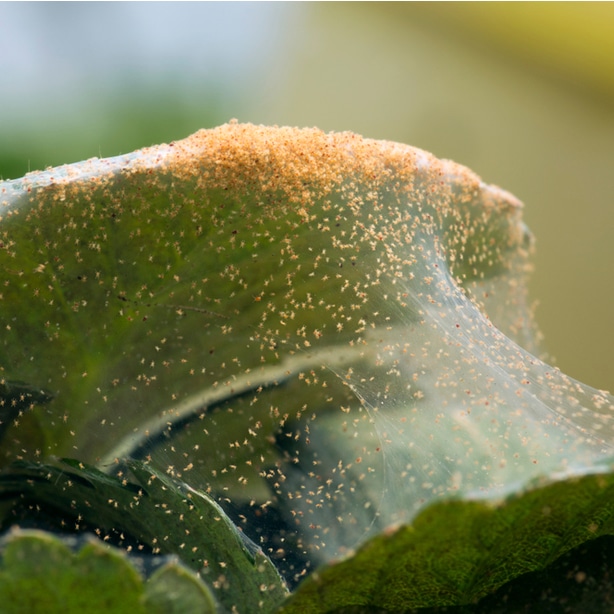
Thrips
Thrips are tiny, slender insects that have fringed wings. They feed on the plant’s sap by puncturing the outer cuticle of the leaves and sucking on the nutrient-rich juice inside. Thrips look like tiny, dark slivers on the leaves and are yellow, brown, or black. Control is critical, as they often spread plant viruses when they feed.
Symptoms: splotchy patches on leaves that turn silver over time, distortion of young leaves, black spots of excrement
Treatment: Introduce natural competitors such as ladybugs to the area, or apply a recommended thrip insecticide according to the label directions.

Diseases
Even though insect pests are nuisances and often an eyesore, growers can often overlook disease problems in rose bushes. The symptoms typically appear as damage to the leaves and aren’t given a second thought until it reaches a devastating proportion. This oversight is unfortunate, as many diseases can completely kill the plant.
Botrytis blight
Botrytis blight is a fungal disease affecting a wide range of plants worldwide. It seems to prefer hybrid tea roses over other types and thrives in cool, humid weather. Problems are usually seen on tender plant parts like buds as well as the canes. It appears as a fuzzy, moldy spot on the infected plant tissue.
Symptoms: bud rot, flower blight, stem rot
Treatment: Remove infected plant parts using clean, sterile gardening tools. Then apply a recommended fungicide to the plant, and other rose bushes in the garden.
Black spot
Black spot is a problematic fungal infection caused by Diplocarpon rosae. It flourishes in cool, wet conditions and is one of the most severe diseases affecting rose bushes worldwide. The leaves are the most susceptible to infection, but gardeners can see problems on all plant parts in extreme cases. Symptoms typically show on the top of the leaves.
Symptoms: dark brown or black spots on upper leaves, leaf chlorosis, leaf drop
Treatment: Remove infected plant parts using clean, sterile gardening tools. Then apply a fungicide registered for controlling black spots to the plants, per the label recommendations.

Cercospora Leaf Spot
Caused by Cercospora rosicola, Cercospora leaf spot is a fungal disease that primarily affects the leaves of rose bushes, especially newly developing foliage. Symptoms show on bottom leaves, moving upward. It tends to appear in the early spring and is encouraged by wet, mild to warm conditions. Spores easily spread through the air to neighboring plants.
Symptoms: maroon or purple circular lesions on leaves, leaf yellowing, premature defoliation
Treatment: Remove infected plant parts using clean, sterile gardening tools. Then apply a recommended fungicide containing the active ingredient chlorothalonil or myclobutanil, per the label recommendations.

Crown Gall
Crown gall is devastating to rose bushes, caused by a bacteria called Agrobacterium tumefaciens. The bacteria live in the soil, often for years, and then enter into the plant through a wound, most often during the warmer summer months. It then inserts a tumor-inducing gene into the plant’s DNA, altering the normal plant cells.
Symptoms: small, spherical swelling around the crown, galls harden into a dark wooden mass, also causes stunting, dieback, leaf discoloration
Treatment: Once infected, there is little chance of treating crown gall. It’s best to remove and destroy the infected plant. Then treat the soil with a registered bacteriacide.
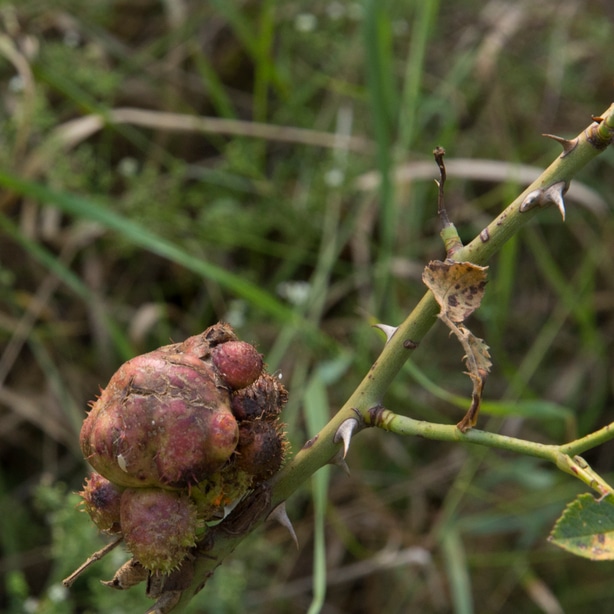
Mosaic Virus
Rose mosaic is a viral disease, not a fungal or bacterial problem. It appears in the spring on a portion of the plant. Several viruses cause the mosaic virus, and they do not directly kill the plant in most cases. However, they can weaken the bush until it isn’t strong enough to survive through a cold winter.
Symptoms: leaf mottling, ring spots, chlorotic line patterns, watermarking, jagged edge pat
Treatment: Once infected, there is no known cure for the mosaic virus. Dig up and destroy the infected plant.

Powdery Mildew
Powdery mildew is just like it sounds — a fungal disease that appears as a dusting of white or light-colored powder on the parts of your plant. Caused by Sphaerotheca pannosa var. rosae, it shows up often in damp environments and humid climates. Moisture and wind help the fungus travel from one plant part to another and even neighboring bushes.
Symptoms: white or grey powder spots on stems, leaves, and buds
Treatment: Remove infected plant parts using clean, sterile gardening tools. Then treat the infected plant and neighboring bushes with neem oil, an insecticidal soap containing baking soda, or a fungicide registered for powdery mildew.
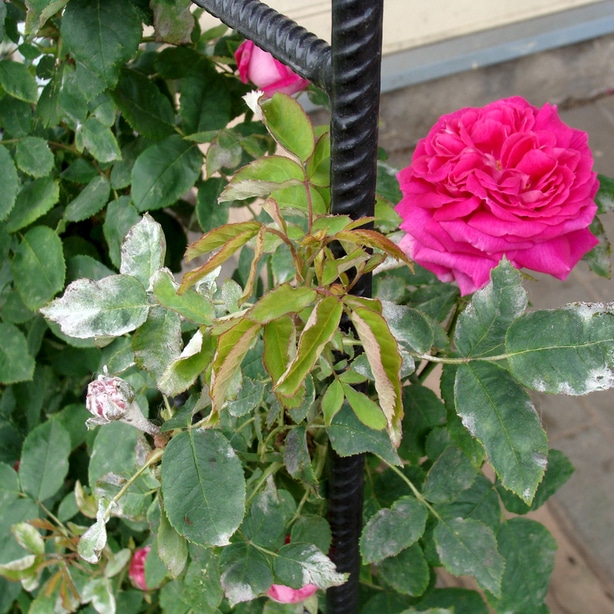
Rose rosette
Rose rosette is a viral condition that causes the plant to grow deformed stems, leaves, and flowers. The virus (Emaravirus spp.) is spread by a teeny tiny wingless mite that travels in the wind. It mainly occurs May through mid-July during the highest periods of active growth. Small plants are affected more quickly than larger ones.
Symptoms: red coloration of leaf veins, increase of red vegetative shoots, deformed leaves, yellow leaf mosaics
Treatment: Unfortunately, there is no cure for rose rosette. Dig up and destroy the infected plant, making sure to remove the entire root system.

Preventative Practices
With both insect and disease problems, keeping the pests at bay through prevention is much easier than treating them once they appear. Most of the following preventative measures are cultural practices that will benefit all plants in your yard or garden, not just your roses.
Strong, healthy plants are better adapted to ward off pests.
- Plant a mixed flower bed with companion plants that naturally repel common insect pests.
- Introduce beneficial insects that are natural predators.
- Avoid overhead watering to keep foliage dry.
- Prune bushes regularly to encourage airflow through the center of the plant.
- Carefully inspect all new plants before they are planted to make sure you aren’t introducing something unknowingly to your garden.
- Clean and disinfect equipment before and after pruning to avoid transferring diseases.
- Dispose of all diseased plant material away from healthy plants. Never add infected material to your compost pile.
- Don’t over-fertilize plants, as this causes stress and weakens their natural defenses against insects and disease problems.
- Keep plants adequately watered.
- Remove leaf litter and other debris on the soil surface surrounding your plants.
- Mulch around the base of plants to prevent spores from splashing up from the soil onto the lower leaves.
- Choose disease-resistant cultivars when possible.

